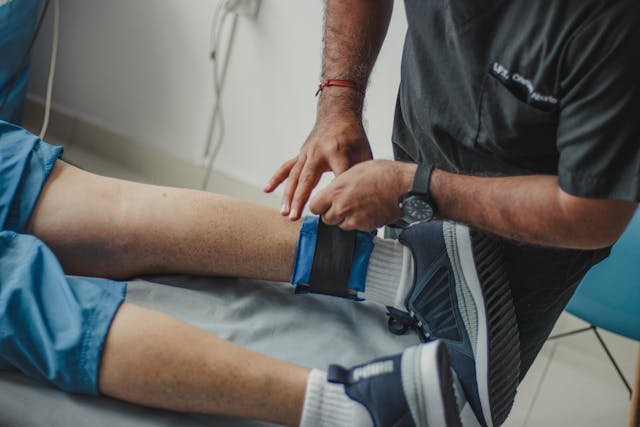
No matter if you’re a seasoned athlete or just enjoy sports on the weekends, injuries are an inevitable part of any physical activity. Although the recovery process can sometimes feel lengthy and frustrating—keeping you away from the activities you cherish—adopting the right strategies can significantly expedite your healing journey and help you return to your favorite sport sooner.
Numerous healthcare specialists focus on sports-related injuries, offering valuable perspectives and techniques to enhance recovery. Different practitioners work on restoring your body’s alignment, optimizing muscle function, and improving overall health to help you feel your best.
In this article, we’ll discuss six vital tips for a swift and effective recovery from sports injuries, highlighting how chiropractic principles are instrumental in your healing process.
1. Rest and Protect the Injury
Our first tip is straightforward: resting and safeguarding the injured area is paramount in the aftermath of a sports injury. This allows your body to initiate its natural healing process.
When you experience a sports injury, it’s crucial to avoid placing any additional strain on the affected area, which could exacerbate the condition. Instead, allow the damaged tissue the time it needs to heal and avoid further damage that may increase inflammation.
During this initial healing phase, consider using supportive devices such as braces, wraps, or crutches to limit movement and protect against further impact.
Combining adequate rest with proper protection enables your body to focus its energy on recovery.
2. The Advantages of Ice and Heat Therapy
If you’re not already familiar, employing ice and heat therapy is a highly effective method for pain relief and rapid recovery. In the first 48 hours following an injury, apply ice to the affected area. This helps diminish swelling and inflammation by constricting blood vessels and numbing discomfort—an essential step to minimize tissue damage.
Once the initial inflammation decreases, transition to heat therapy. Heat works to relax tight muscles, enhance blood circulation to the injured area, and alleviate stiffness, facilitating easier restoration of mobility.
Utilizing these therapies effectively can accelerate your recovery from sports injuries.
3. Explore Chiropractic Adjustments
If your injury is severe or is taking longer to heal, chiropractors can assist in correcting misalignments in the spine and joints to aid recovery. Trauma, even if minor, can disrupt your body’s natural alignment, resulting in pain, reduced mobility, and slower healing.
A chiropractor can employ precise techniques to restore alignment, alleviating nerve pressure, improving joint function, and facilitating your body’s natural healing processes.
These adjustments aim to relieve pain and optimize your body’s biomechanical balance. You’ll soon find yourself regaining mobility and returning to your preferred physical activities faster than anticipated.
4. Gentle Stretching and Strengthening Exercises
Once the initial pain and inflammation have diminished, it’s time to incorporate stretching and strengthening exercises into your recovery plan.
Gentle, low-impact stretches help maintain and enhance flexibility, enabling the injured area to gradually regain its range of motion and reduce stiffness. Strengthening exercises will help rebuild muscle function and stability around the injury, providing better support against future injuries.
However, ensure that you perform these movements cautiously and ideally under the guidance of a professional to avoid overexertion.
5. Prioritize Proper Nutrition
Recovery extends beyond rest, movement management, and exercise; nutrition plays a critical role. Adequate nutritional intake is vital for recovery post-injury, as it provides the essential building blocks for tissue repair and inflammation management.
Focus on a diet rich in protein to support muscle regeneration, and include vitamin C to aid collagen production, which is crucial for repairing connective tissues.
Incorporate anti-inflammatory foods such as leafy greens, berries, nuts, and fatty fish to help manage swelling and discomfort.
Remember to stay hydrated and limit sugary foods to ensure your body receives the nutrients it needs for a swift recovery.
6. Gradually Resume Activities
Eventually, you will feel ready to return to your preferred activities as your injury heals. However, it’s essential to ease back into physical activities gradually, ensuring that you do not hinder your healing process.
Rushing into intense activity too quickly can place excessive stress on healing tissues, raising the risk of re-injury. Instead, start with light, low-impact movements to build strength and coordination.
Also, pay attention to your body’s signals; it will guide you on whether to proceed or slow down based on your comfort level.
7. Consider Regular Sports Massage
If you’re looking to enhance your recovery further, think about professional sports massage therapy, which offers numerous benefits and complements your rehabilitation efforts.
Sports massage targets soft tissues, helping to alleviate muscle tension, break down adhesions, and improve circulation—delivering necessary oxygen and nutrients to the injury site.
Increased blood flow aids in flushing out toxins and reducing inflammation, leading to faster healing.
Additionally, sports massage can help prevent scar formation and ensure that the affected muscles and joints regain their full range of motion.
Beyond its physical advantages, sports massage can relax you, reduce stress, and create an optimal environment for complete and speedy recovery.
Achieving a Healthy Comeback from Sporting Injuries
Fully recovering from a sports injury necessitates patience, dedication, and the right approach. With these tips in hand, you can pursue a healthy recovery and minimize the risk of re-injury.
Keep in mind that each injury and every individual is unique, so consulting with professionals like chiropractors and physical therapists can further ensure that you stay on track with your recovery.
By implementing these best practices, taking your time, and engaging with experts, you’ll soon find yourself back to performing at your peak.







